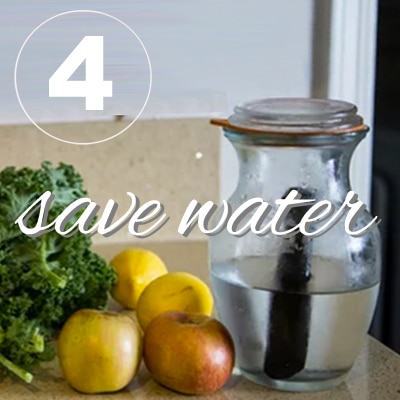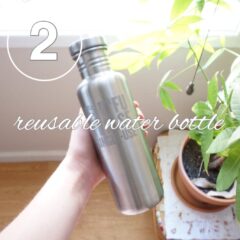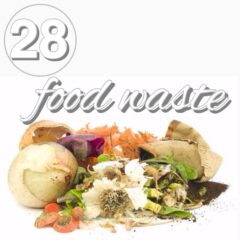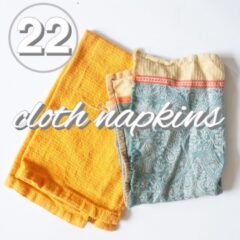Last Updated on January 31, 2023
This challenge to reduce water waste really opens your eyes to just how much water you use in a day. As much as it seems that it is, water is not an infinite source, and water reduction at home is a great way to ensure we still have enough for future generations.
The Waste No Water Challenge is part of my 31 Day Zero Waste Challenge. Reducing consumption of water at home just a little bit each time you turn on the faucet can add up in a huge way! These water waste solutions are attainable ways for every person to reduce water waste and do our part to keep the planet healthy.

Table of Contents
reduce water waste at home
It blows my mind that the average American home uses 400 gallons of water a day! Water is a precious resource that we should all focus on conserving for the good of the many.
Only 1% of the earth’s water is actually drinkable. We’re so used to turning on the faucet, we forget it isn’t infinite.
All of us taking small measures to help reduce water at home adds up to a big impact!
why you’ll love these water waste solutions
- So easy! These 10 solutions will save water with very little effort on your part!
- Conserving water saves you money on your water and utility bills
- It feels good to do our part for the planet and reduce the pollution that wastewater causes
the waste no water challenge:
The Waste No Water challenge is simple: save water! It’s part of my overall Zero Waste challenge to move toward more sustainable living as a whole.
To make things easier for my readers, I’ve even compiled a list of my top 10 easiest ways to save water without even trying.
my favorite water reduction methods
save water indoors
1. Turn off the faucet: Whether you’re washing you’re hands, face, or brushing your teeth, turn off the faucet while it’s not in direct use.
2. Keep it full: If you’re doing a load of laundry or dishes, make sure the load is full! Using a dishwasher actually uses less water than hand washing.
If you don’t have a dishwasher (like me), plug the sink. Fill it with a little soapy water. Wash all of the dishes in the tub, then rinse them.
3. Use a bowl: When washing produce, do it in a bowl or a tub, so you don’t have to keep the water running.
4. Catch the ice cubes: Most of the time my dog gets to them first. But, if Nala isn’t around, I like to place them in my plants.
5. Keep a bucket in the shower: We keep a bucket in the shower to catch water as we bathe. We use it to water the house plants. Or, I’ll hand wash my delicates in the bucket and take them out to dry.
Do it early in the morning when it’s not windy. You’ll have less evaporation occur.
6. Mellow: We’re big believers in yellow let it mellow. This means you don’t flush the toilet for number 1.
7. Break out the real plates: People often advocate for disposables, because washing dishes wastes water. Which couldn’t be more false. It takes 8 gallons of water to make one paper plate.
Do you think it would take you 8 gallons of water to wash a cup and a plate?
save water outside
8. Water in the morning: If you have a lawn, don’t water it every day. And, when you do water it, make it count.
9. Fix your leaks: Give your pipes a good tightening!
10. Upgrade: Low flow toilets, low flow shower heads, gray water tanks, and changing up your landscape — there is so much you can do to make your home more efficient when it comes to water.
Installing a gray water tank is on our list for this year! It’s going to be a simple DIY tank from the washing machine used to water our future veggie garden.
faqs
why is it important to save water at home?
Water reduction at home has so many benefits. Plus, you’re in control in your own home whereas you have less say in water use in a broader community. Saving water means saving money. It means reducing pollution. It can even delay (or completely prevent!) the expansion of costly water and wastewater treatment plants in your community. This can save money on taxes, among other things.
why is water waste a problem?
To put it plainly, depleting our water supply can put human health and the environment at serious risk. Lower water levels can contribute to higher concentrations of natural or human pollutants. Reducing our water consumption can keep the population safe.
What are some of your favorite water waste solutions?














I think the best way of saving water is going fully vegan. The meat and dairy industries use so much water that all the mellowing and navy-showering looks ridiculous in comparison. Thinking you will get major results with just fixing leaky pipes and watering your lawn a bit less is naive at best, but I’m afraid it’s actually just looking the other way and pretending that the many cons of animal agriculture are a different issue. They’re not.
The zero waste life style is usually plant based, if not vegan. Also, we shouldn’t stop at just going vegan to make the world better. These practices will make us appreciate water more, and the gallons add up.
You’re so right! It all adds up. Everyone can improve in some area. 🙂
I have a composting toilet, I wash the dishes over a big which gets emptied onto the plants after I’m done.
But the biggest water-saving choice I make is to not buy any animal products
Being Vegan.
My grandparents always used a plastic tub in the sink for hand washable items. When they were done washing, they’d take the tub outside and water the garden.
I am still learning but I was wondering…. If your using sink container or shower bucket to water your plants/garden…. Would the soap or shampoo harm the plants??
Great question. We use castile soap which is biodegradable. Make sure the soap you’re using is biodegradable and it’ll be fine.
I always try to save our valuable water. Though we use the plastic tub in our house. Thanks for sharing, seems it’s a good and benefited those, whose are like to take shower, like to care their shower. http://showermade.com/2016/01/27/best-shower-head-water-softener/
I always try to save our valuable water. Though we use the plastic tub in our house. Thanks for sharing, seems it’s a good and benefited those, whose are like to take shower, like to care their shower. http://showermade.com/2016/01/27/best-shower-head-water-softener/
Lol. In re ice cubes, I read "If Nala isn’t around, I like to place them in my pants." Really, who knew. It’s so darn hot in Arizona during ice cube season, that sounded like a pretty good idea for a second.
I keep a bucket in the shower and my #1 use for it is to flush the toilet. Tip about 90% of the water into the toilet quickly, it will "swallow" and leave almost no water in the bottom. Then use the last bit to fill the bowl back up again. This is a lot simpler than trucking it out to the garden, and i have no issues with soap or other contaminants, they were going down the drain anyway.
Just to add, I do my best to use products that are environmentally friendly, it’s not like I’m rinsing lye into the sewer, I just meant that this way if there was something in my soaps that plants don’t like, it’s not an issue.
We took a vacation in Japan that changed the way I thought of toilets forever. (Other than the bidet life), we came across a frequent amazing incorporation to a lot of home bathrooms. Toilet tank sinks?!? Gives you the chance to wash your hands with the clean water that will be used to refill the toilet tank. After getting back to the states after this trip I was very happy to find that you can find inserts for this over here too! The only thing stopping me from getting one so far is trying to find one that is not plastic.
Don’t forget the water that you use for boiling eggs or potatoes. This water can be used for watering the plants. It even contains a lot of nutrients that will help the plants grow. 🙂
i line dry clothes and don’t use the dryer because electricity heats a lot of water and it a big factor in individual water use and how to cut back.